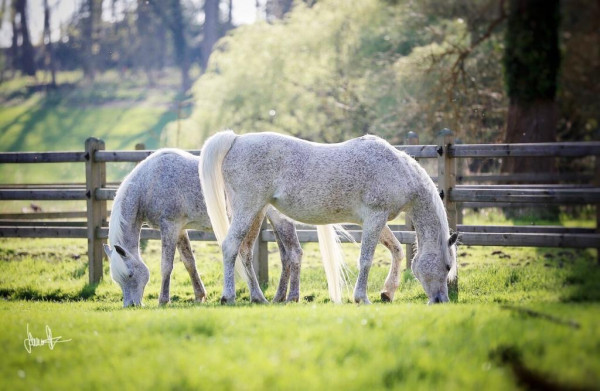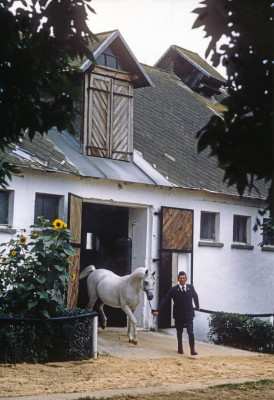Where Does Your Horse’s Feed Come From?
by Cindy Reich
In late August, dozens of horses were reported dead at the famed Beutler and Son Rodeo Co. ranch in Oklahoma. They have bred and raised rodeo stock for nearly 100 years, and their bucking horse bloodlines go back that far. Nearly 80 horses died, and their breeding program was essentially wiped out. The cause? Contaminated feed from a mill they used that did not (presumably –the case is pending) clean out the mill adequately between running cattle feed and horse feed.

In over 20 years of writing and reading about horse health topics, I have seen these reports repeatedly, yet it still happens. Everyone who owns a horse needs to understand this issue.
One case I reported on about 14 years ago (not the Beutler case) started innocently enough. The morning feeders noticed that a couple of horses were acting abnormally. Two were down in the pasture and had difficulty getting up. Another one was walking erratically, wobbling and weaving as if drunk.
When the feeders entered the barn, most of the horses were standing at the front of their stalls, looking for their breakfast. However, a couple of them looked depressed, with drooping heads, and showed no interest in food.
The owner of the farm was called immediately, and she quickly arrived to assess the situation. As she walked the barn and the pastures, the feeders went about their work, feeding the horses. Alarmed by what she saw, the owner called her veterinarian. Out of approximately 40 horses on the farm, five seemed to be acting abnormally. The veterinarian examined the horses, took blood samples and conferred with the owner. They reviewed the vaccination history of the affected horses, and all were up to date on vaccinations. Many of the symptoms could be caused by a variety of causes, so the veterinarian would call back as soon as he had the blood results, and they would go from there.
Don't be afraid to ask what their protocol is for cleaning out the mill between livestock and horse runs of feed. |
None of the horses were showing gastrointestinal problems aside from one horse that had diarrhea. The symptoms were more neurological in terms of the wobbly gait and hind end weakness shown by one of the pasture horses.
Obviously the list could be long in terms of what could be going on. West Nile, encephalitis, and the neurological form of the equine herpes virus
could result in the same symptoms, but the horses had been vaccinated regularly. While vaccinating doesn’t guarantee protection, most horses are adequately protected by their vaccinations. Furthermore, none of the horses was running a fever – at least so far. Three of the horses were kept outside on pasture and two were kept in the barn. If the pasture horses had eaten some sort of toxic plant, the horses in the barn should not have been sick.

As the day progressed, the affected horses continued to worsen. More alarmingly, several previously normal horses started showing symptoms — the wobbly gait, muscle weakness, sweating, and labored breathing.
The veterinarian reported that the kidney values were abnormal in several of the horses, plus there were signs of muscle deterioration and damage reflected in high muscle enzyme levels. This very likely pointed to some sort of toxin or poisoning that was breaking down muscle. The only thing that was common to all the affected horses was they all received the same grain. Also, significantly, all the horses that did not receive grain were acting normally. The owner used a custom mix from her local feed mill for her horses. She immediately stopped all feeding of grain and submitted samples from the remaining bags in the feed room for analysis.
The Cause
When the grain analysis came back, the results identified the toxin responsible – Monensin also known as Rumensin in the U.S. and Coban in Canada. Monensin is an antibiotic routinely used in livestock and chicken feed to increase growth and development. The problem is that horses are extremely sensitive to Monensin compared to other livestock species. Monensin is an ionophore, a chemical that controls ion transport between cells. In cattle and chickens, for example, it can also control some transport of parasites. However, in horses, it interferes with sodium and potassium ion transport in the muscles, particularly in the heart. This ultimately can result in damage to the muscles, but also in cardiac failure.
Monensin has been used routinely in livestock feed since the 1970s, however, it has also been poisoning horses for the same amount of time. It is illegal to add Monensin to horse feeds. What generally happens is that a mill running feed for livestock does not adequately clean out all the equipment before running horse feed and the horse feed becomes contaminated. That is the most common occurrence for Monensin poisoning.
If you have livestock (sheep, swine, cattle, or chickens) along with your horses, make sure the feed for the horses is kept separately from the livestock and chicken feed. Make sure your employees know the difference and do not confuse feeds. |
However, on working ranches, feedlots, and other operations that have horses and cattle in close proximity, it is possible for staff to mistakenly feed horses grain meant for cattle, or for horses to gain access to spilled cattle feed. Monensin is not only toxic to horses, but dogs as well. Because dogs only have a single stomach (as do horses) they process Monensin differently.
Cattle can consume 10 times the amount of Monensin than horses with no ill effects. Therefore, with the level of Monensin in the feed calibrated for cattle, it takes only a very small amount to poison a horse. Even if there was just a trace amount of Monensin in the horse feed, eating it daily over time could cause devastating results. Unfortunately, since the symptoms of Monensin poisoning mimic many other conditions, it may be several days before feed contamination is suspected.
How is Monensin Poisoning Diagnosed?
Since the ionophore breaks down in the horse quickly, tissue samples are not generally diagnostic. Since it most seriously affects the heart, horses with very high heart rates, combined with labored breathing and difficulty in walking or getting up and down must be considered suspect. Again, these same symptoms could be seen in a severe colic. However, if multiple horses are showing signs at the same time, it would be very unusual to have multiple severe colics happening simultaneously.
Blood work that identifies an increase in enzymes connected with muscle damage is significant as well as high myoglobin (muscle protein) levels in the urine. This type of bloodwork can also be indicative of high lactic acid levels and muscle damage found in horses with tying-up syndrome (exertional rhabdomyolysis). These horses usually are reluctant to move or walk, have a very stiff gait and can sweat profusely. Again, multiple horses having this simultaneously at a single farm would be unlikely.
Therefore, taking blood and urine samples in this sort of situation would be helpful in narrowing down the diagnosis. However, sometimes the only conclusive diagnosis might be obvious damage to the heart found on necropsy. The best way to definitively diagnose Monensin poisoning is to have the feed tested.

Short Term/Long Term Effects
Depending on the amount of Monensin consumed, the effects could be very quick and very tragic. Since horses are 10 times more sensitive to the amount of Monensin used for cattle and 100 times more sensitive to the amount used for chickens, consuming even minimal amounts can result in cardiac failure and death.
If the horse has not consumed a fatal amount, or has consumed trace amounts over time, damage to the heart muscle or other muscles can occur and will be permanent. Horses that recover from Monensin poisoning can suffer from heart or muscle problems when exercised. This can result in a horse that potentially could never be used for riding or driving. Since the muscle damage is not visible or particularly measurable, there are many reports of horses dying months or years after exposure.
How To Prevent Monensin Poisoning?
Unfortunately, since the seventies, there have been countless cases of Monensin poisoning involving large and small feed mills. If you buy a custom feed made by a regional or local mill, it is important to talk to them about how they run the mill. Don't be afraid to ask what their protocol is for cleaning out the mill between livestock and horse runs of feed. Ask if they use Monensin in their mill and what steps they take to prevent contamination. Ask if they have ever had an instance of contaminated feed. Take control of the feed you use and make sure you know what the feed mill is doing.
If you buy a commercial feed from a mill that ONLY produces horse feed, the chances are minimal that your feed could be contaminated. However, it is still a good idea to check with the company and find out what their involvement is (if any) with running livestock feed through their mill. If they run any livestock feed at all, you must consider that a risk factor.
Horses and cattle go together like peanut butter and jelly. Therefore, if you have livestock (sheep, swine, cattle, or chickens) along with your horses, make sure the feed for the horses is kept separately from the livestock and chicken feed. Make sure your employees know the difference and do not confuse feeds. Any spillage of livestock or chicken feed must be cleaned up immediately. Do not allow your horses access to livestock feed. For example, no wandering of horses in areas where there are troughs where livestock is fed. Do not feed horses and cattle in the same environment unless you know for certain that there is no Monensin in the feed.
Check all supplements that are used for livestock before use; some supplements that are not grain based can contain Monensin. Again, if Monensin poisoning is even suspected, immediately pull all grain at the first signs until testing can occur. Your horse can live quite well without grain but can die quickly if the grain is contaminated. And, as there have been multiple instances, year after year, decade after decade, it is clear that many horse owners still do not understand the dangers of Monensin in feed.
Monensin certainly increases the health and productivity of livestock and poultry but can never be around horses. It will continue to be used in the livestock and poultry industries, so it is up to horse owners to become educated and keep it away from their horses.

























